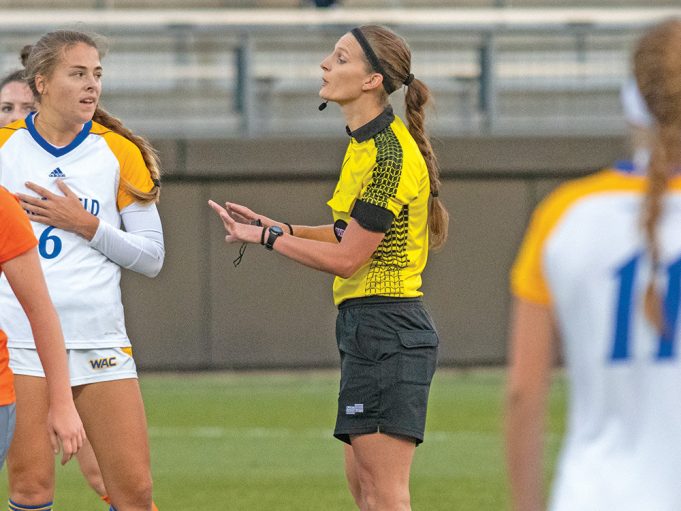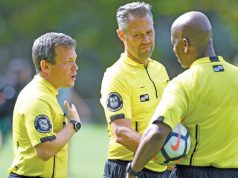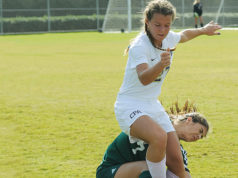Appropriate communications (ignore, body language, non-verbal signals including whistle and general accepted hand signals and verbal) are used to match level and skill of play. This applies to all levels beginning at club to high school and all the way to high-level NCAA and professional leagues, along with gender of both the players the coaches and related coaching staff. During the pregame, the referee warms up, checks rosters, balls, player equipment, etc. During this time the coaches and players are observing how professional the referee team acts. First impression by the players’ and coaches’ perception of the referee team is lasting.
An official’s communications or response to comments varies from ignore to acknowledgement to verbal response. The referee must have the ability to know the difference and the message he or she is sending in response to the communications (verbal or non-verbal) sent. The referee must be able to differentiate statements, questions, potential dissent, inappropriate language, gestures and non-verbal communications from the players/coaches and the situation surrounding these communications.
Ignoring this communication does not validate the communication. It may be just game chatter. By acknowledging the communication, the referee lets the player know that he or she has been heard and their statement/comment/remark has been noted. A simple reply of, “I heard you,” acknowledges the player and will assist with game control by defusing the situation. A simple reply of, “I will handle it at next stoppage,” is another good way to acknowledge the statement as something the referee needs to manage. If this comment is made, the referee must ensure that he or she does indeed follow up and not let the issue escalate.
When communicating with players or coaches, the first step is letting them know why you are stopping play to communicate. A referee’s personality is a good tool to assist with control during these situations. For example, when communicating with a coach, the referee may start by stating, ”Coach, you worked awfully hard to get my attention. What would you like to ask me?” It is important to listen to the coach, then respond in a professional manner and walk away. Debates only lead to more problems. Another example is, “Coach, I heard you say, ‘You are terrible’ on that last foul. Are you telling me that I am a terrible person, which could be considered foul and abusive language, or did you mean that call was terrible?” A little humor can go a long way to relax a coach if the referee has the personality to deliver it in a manner that will bring about a positive result. Choose the words carefully. A comment can put fuel on the fire just as easily as it can extinguish the flame.
Non-verbal body language is the most important form of your communications between 60 and 90 percent of the time. A head nod that indicates the comment has been heard may resolve the situation. A stern look at a player who committed a foul can go a long way in letting the player know that the behavior is unacceptable. A smile can indicate that the referee heard the remark and may even enjoyed the way it was delivered. Raising the hand in a “stop” motion clearly tells a player that the referee is not going to condone anymore of the particular style of play.
Another communication style is voice inflection (not what the referee says but how) and actual words used to express the thought. A good rule of thumb is to use the KIS method (keep it simple) and to the point. The referee must be composed when speaking and ensure the player/coach focuses on the words and not the referee’s emotions. Debating with a player or coach will only create a losing situation for the referee.
Referees must maintain their composure, professionalism and be aware of their body language, think before they respond and then respond in a chosen style or technique. The physical approach, attitude, body language and stance, and eye contact will determine the environment and will bring about a positive result.
Eye contact is another important part of non-verbal communication. A referee who looks down when speaking to a player/coach provides an appearance of weakness. Looking over the player/coach creates a feeling you’re speaking down to them rather than at them. Look the coach/player in the eye when communicating. This is a sign of strength.
A relaxed body stance and gestures, soft voice tone, meeting with the player at a neutral site and a slow indirect walk toward the touchline to meet the coach are all ways to indicate that the referee is not threatening in any manner but is approachable and ready to listen and provide a professional response.
A referee who utilizes a rigid approach or method with a rigid body stance, military type march with head up and shoulders back, straight and stiff body, short and quick gestures, harsh voice, approach directly in control method or with stare-type eye contact creates an appearance of confrontation.
If a decision has been made prior to approach of a dismissal/ejection/send-off, then just “do it” — tell the player that his or her unprofessional behavior is unacceptable, point upward at 45 degrees, display the red card, and turn and walk away. No further discussion is necessary. The less said in this type of situation the better. Remember, the reason for the ejection must be a reason as indicated in the rules or Laws. Also, the referee must keep his or her emotions under control. Eject the player and restart the match.
Communication, both non-verbal and verbal, will help or hinder a referee’s ability to control a match. Choose the words wisely and always remain professional.
What's Your Call? Leave a Comment:
Note: This article is archival in nature. Rules, interpretations, mechanics, philosophies and other information may or may not be correct for the current year.
This article is the copyright of ©Referee Enterprises, Inc., and may not be republished in whole or in part online, in print or in any capacity without expressed written permission from Referee. The article is made available for educational use by individuals.


















